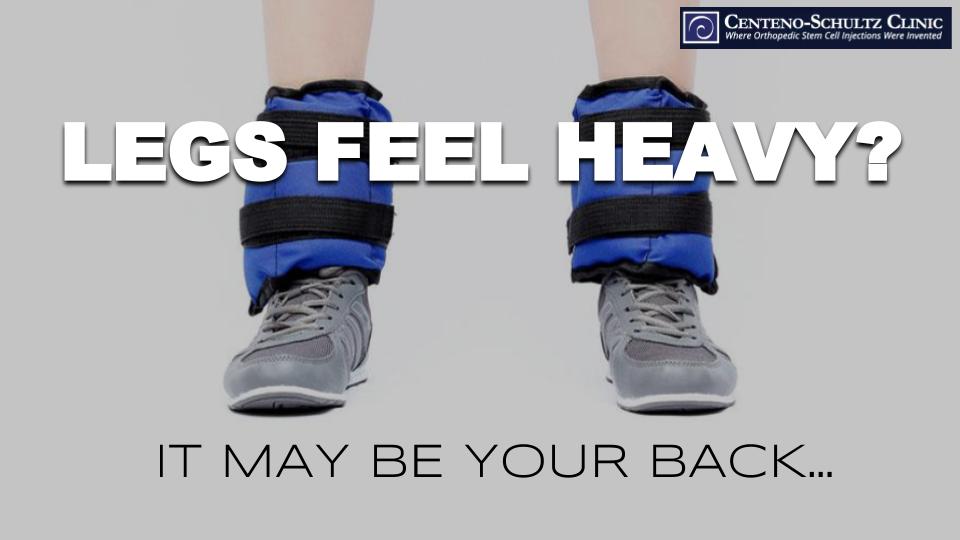If you suffer with heavy legs, you are probably well aware of how it feels. If you feel at times like you’re slogging your way through a pit of mud; like your body expects to go faster, but your legs are just moving in slow motion; like that spring you used to have in your step is completely gone; or like you have heavy weights permanently affixed to your legs, you are likely struggling with heavy legs. Maybe you’ve tried strengthening exercises or stretching techniques, but these probably haven’t helped. Why not? What if we told you your heavy legs could be a symptom of a back issue? Our own Dr. Centeno started having problems with heavy legs last year, and the root of the problem was found in his back. Watch his video below:
The Cause of Dr. Centeno’s Heavy Legs
As Dr. Centeno mentions in his video above, he could no longer bound up the staircase from his office to the clinic. He’d had enough of feeling like he was walking around with heavy weights on his legs and struggling with the stairs—doctors can sometimes be the most stubborn when it comes to seeking treatment—and he finally decided to find the cause of his heavy legs problem. Where was it found? In his back. Let us explain.
The spinal cord is a bundle of nerves that run through the spinal column. Nerves branch off the column at every level and supply all parts of the body. The nerves in lumbar spine located in the lower back branch into the legs and control muscle function. If the nerves in the lumbar spine are irritated, this can present as symptoms anywhere along the nerve branch. So an injury at a spinal nerve can present as pain or irritation in the leg (e.g., numbness, tingling, tightness, etc.), and you may not feel a thing in your spine. So the key is to treat the source of the problem, in this case, the spinal nerve.
In addition, because the nerves aren’t properly controlling and managing muscle function, this can make the legs feel heavy. Incidentally, if left unaddressed, lack of nerve supply to the muscles can even result in muscle wasting. These same nerves also supply the multifidus muscles (those deep core muscles), forcing them off-line and causing other muscles that aren’t designed to do their job to pick up the slack, stressing those muscles in the process. Instability can also occur in the supporting ligaments, destabilizing joints and discs in the process. So now the entire core is not functioning well and not properly supporting the legs.
Treating Dr. Centeno’s Back Fixed His Heavy Legs
Addressing Dr. Centeno’s heavy legs involved treating an irritated nerve at the S1 level in his lower back. One of our other physicians drew blood from his arm and processed the platelets, isolating the abundant healing growth factors and precisely injecting them around Dr. Centeno’s S1 spinal nerves (S1 transforaminal epidural). Dr. Centeno was already aware that he had an L5–S1 disc bulge, which can press on the spinal nerves, causing problems in the legs. The S1 injection calmed his irritated nerves, allowing good signals to again reach the leg muscles. In addition, treating that S1 nerve also addressed his core muscles that had also been impacted, evidenced by his ability to increase his weights utilizing his core by 25% while working with his personal trainer 45 minutes after his treatment.
What about those stairs from his office? The next day, he bounded right back up those stairs again without a problem.
Do Platelet Growth Factors Really Work That Fast?
Ten minutes after platelet growth factors were injected around Dr. Centeno’s irritated S1 nerve, his heavy legs were gone, and shortly after he was working out his core and was able to significantly increase the weight. Do platelet growth factors really work that fast?
Some of the growth factors in platelets as well as the cytokines in the blood serum (e.g., A2M and IRAP), are potent anti-inflammatories and reduce swelling fast. Some are pro-growth, on the other hand, and can build new blood vessels or even help sprout new nerves for example. Dr. Centeno’s fast initial response was likely due to the anti-inflammatory effects of the cytokines and the dilution of inflammatory chemicals due to the volume of fluid calming the nerves.
If you’re struggling with heavy legs, we don’t recommend slogging through the mud for months, like Dr. Centeno. The key is to stay on top of your body’s signals, whether it’s heavy legs or anything else, and have issues proactively addressed before they advance, whether that’s with platelet growth factors or some other orthobiologic. See your interventional orthopedic physician as soon as possible so he or she can trace the source of the problem and, in most cases, treat it quickly.

